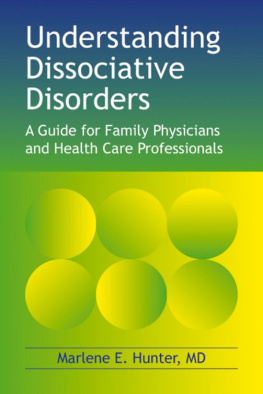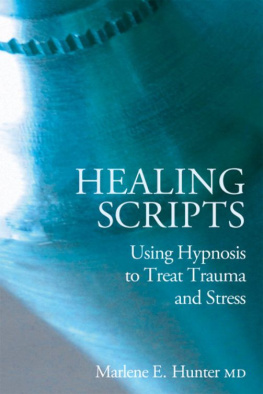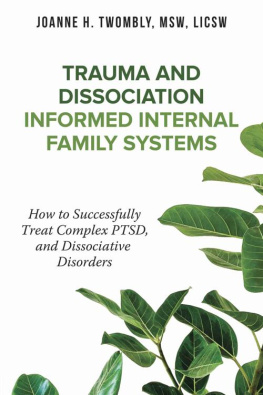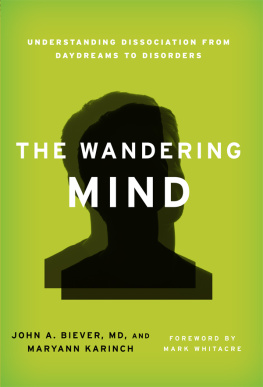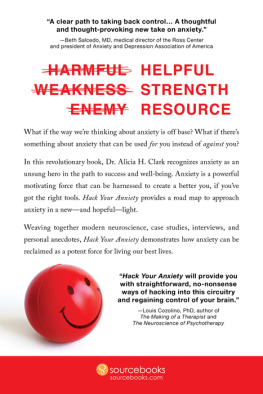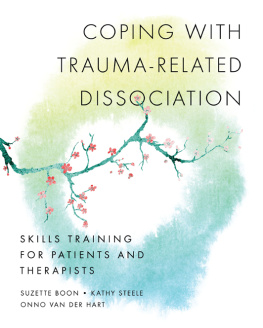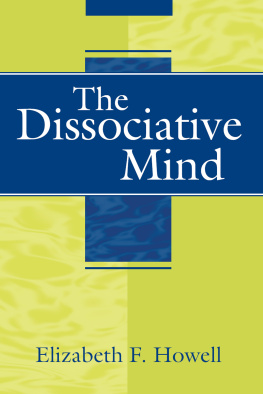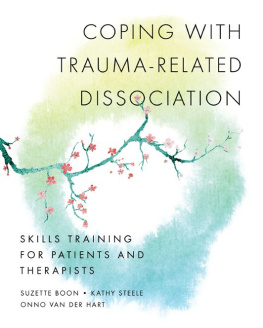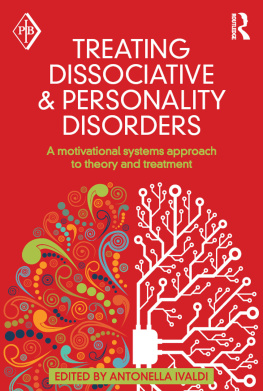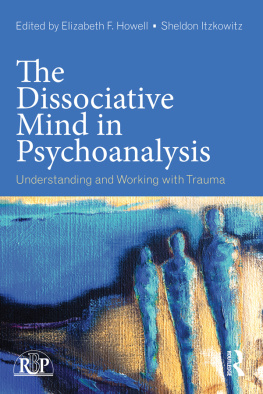My deepest appreciation to all my patients, especially in those early years of struggle, who taught me what I had to know about dissociative disorders. You are a wonderfully courageous bunch of people.
Also I want to thank Betty Jo Critchfield for her help with the references; you saved me endless hours of work and did a much better job than I would have.
I saw my first dissociative patient (at least the first one that I recognized) in 1977.
I am a family physician. I had become very interested in the medical and psychological uses of hypnosis in 1972, and within five years it had become a routine part of my everyday practice. When a colleague phoned to say that she was moving out of town and asked if I would accept one of her patients (I know youre not taking new patients, Marlene, but this woman really needs you), I agreed.
Thus began a journey that never in my wildest imaginings would I have anticipateda view into the inner world of the highly dissociative patient. Slowly, I realized that I had another such patient in my very own family practice, and yet another.
She was a pleasant and intelligent patient, and I liked her immediately. In her late twenties, she had a very responsible job in the government offices, which she did well. However, she drove me to distraction, because I never knew where I was at with her. She suffered from terrible headaches; I would prescribe the newest pharmaceutical miracle, she would phone me from work and say, That medicine is wonderfulwhy didnt you give it to me earlier? And then, three hours later, she would be sitting in my office and when she saw me would glare at me and say, What did you give me that crap for? It isnt worth the paper its printed on!
I will call her Jayere, because that is the name I have given her in various papers that I have presented.
Jayere had a documented history of early child abuse. My colleague had done some hypnosis with her and taken her (in hypnosis and at the patients request) back to a birth experience, in which Jayere reported that she had heard her mother say, Take the little bitch away.
Now, whether that really happened is not the issue. The issue is that this is what she believed, and if that is how one believes one has been greeted on entering this world, it doesnt bode well for ones future emotional harmony.
In fact, the birth mother deserted the child and the husband when Jayere was three weeks old. The husband, not well educated and in a laboring job, with absolutely no knowledge or experience of children let alone a weeks-old baby, passed her around to various friends so that he could go to work. Ultimately, at the age of thirteen months, she was found on the beach, wrapped in newspaper and left for dead, having been hit in the head with a beer bottle. Bits of beer bottle glass were embedded in her tiny scalp.
She was in several foster homes over the next few years and, at the age of five, was adopted into a family where (as she told me) strict discipline was the order of the day.
As our doctorpatient relationship became established and grew, I became more and more confused. She had had, from previous family doctors, twelve psychiatric referrals. These resulted in twelve diagnoses. I made the thirteenth referral, and thus she received the thirteenth diagnosisthat she had a neurological disorder, not a psychiatric problem. The neurologist, however, said in no uncertain terms that she had a psychiatric problem, not a neurological disorder, although he could not account for the fact that on two separate occasions she had had two distinctly different EEGs.
One day, some months after she had come in to my practice, I was at an American Society of Clinical Hypnosis meeting, where there was an opportunity to discuss problem cases with one of the older physicians or psychologists. Serendipity found me with a psychiatrist from California, Dr. Donald Schafer, who listened very carefully and asked some pertinent questions. Finally he leaned back in his chair and said, Have you ever thought of multiple personality disorder?
Im sure I blanched. No, I croaked.
Well, I think you should think about it. She has all the criteria.
So I thought about it. And did nothing. And then, several months later, at another hypnosis meeting, I was listening to Dr. Jack Watkins talking about MPD (as it was called then) and I said to myself, Marlene, why are you refusing to believe your own eyes and ears? He is talking about your own patient.
So, with gritted teeth and feeling scared stiff, I gathered all my courage together at one of my next meetings with Jayere and asked, while she was in hypnosis (we were working on relieving the headaches), Is there any other part of you who would like to come and speak with me?
And this entirely different voice gruffly said, Of course! What took you so long?
What does dissociative disorder mean?
In essence, dissociative disorder means an incredible ability to compartmentalize ones mindbut to the point where, in the adult, it often becomes dysfunctional rather than useful.
The term multiple personality disorder did a great injustice to the field of dissociative disorders, in my opinion. Although coined with the best of intentions, it was flamboyant and melodramatic and, as we now know, wrong. Dissociative patients do not have multiple personalities: they have a personality structure that is separated into neat little categories and therefore compartmentalized . My metaphor is of a post office, with many post office boxes. Some of the boxes are closed, some locked tight, some with doors ajarbut there is only one post office.
The new term, dissociative identity disorder, is more accurateand less pejorative. Many patients have all, or almost all, of the post office boxes open: it is then termed DDNOSdissociative disorder not otherwise specified. The terminology alone is enough to send you screaming in the opposite direction.
The professional jargon for my post office boxes is ego states. We all have ego states: I explain to my patients that I am a slightly different person sitting here in the office than I am at home, different as a wife than I am as a mother, different in the lecture hall than when Im enjoying myself with my friends. Its normal. Im lucky, howeverall my ego states know each other so all the post office boxes are wide open; indeed, there are only little screens between them instead of metal walls. It is when there are amnesia barriers between the ego states, so that they do not know each other, that we have a true dissociative disorder.
We used to think that all dissociative disorders were the result of severe emotional, sexual, or physical childhood trauma, especially when the child was very young and the trauma was ongoing, and it is sadly true that that is very often the background. However, there has always been the occasional patient in whom we have not been able to attribute the dissociative symptomatology to such a history. Such anomalies have ultimately led to a whole new understand and basis: the attachment theory, first described by Dr. J. Bowlby (1969).
This theory proposes that some children, as very tiny babies, do not have the warm experience of learning a sense of positive attachmentin other words, they have a less than perfect sense of security and trustto the primary caregiver, who is usually the mother. Instead, they may grow up being somewhat ambivalent about it, or even avoid issues that would demand that the mother show her emotional reliability. This does not necessarily imply abuse, or neglect. It could be that the mother is suffering post partum depression, for example, or her husband is going off to war, or the baby itself is in the hospital, or any one of many other possibilities where there is an interference in the normal deep connection between the very small child and his or her nearest source of security andone hopeslove.

